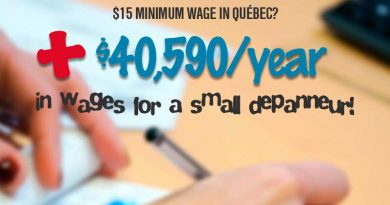16% increase in Quebec’s minimum wage by 2020
If most convenience stores are barely profitable in Quebec, one of the culprits is certainly the unbridled increase in Quebec’s minimum wage.
The problem is not so much that it increases: the problem is that it is growing much faster than the rate of inflation. This means that convenience stores are doomed to generate new revenues or cut expenses to barely maintaining their current level of profitability.
In fact, the Quebec government as well as most of the other provincial governments are quite agressive when it comes to the minimum wage.
After openly juggling with the idea of seeing it raised to $ 15 / hour as is or will soon be the case in several cities of our neighbors to the South (see list here), and having unnecessarily inspired and mobilized every imaginable left-wing groups in Quebec, the government finally made its bed by not proposing one but four wage increases from 2017 to 2020!
These four increases total $ 1.70 per hour on a salary of $ 10.75, or nearly 16% increase by 2020.
The following table shows the picture of past and future increases:
Minimum wage increases in Quebec vs inflation (2007-2020)
| 2007 | |||||
| 2008 | |||||
| 2009 | |||||
| 2010 | |||||
| 2011 | |||||
| 2012 | |||||
| 2013 | |||||
| 2014 | |||||
| 2015 | |||||
| 2016 | |||||
| 2017 | |||||
| 2018 | |||||
| 2019 | |||||
| 2020 | |||||
It is striking to see that every year, for the past 10 years (except in 2011), the minimum wage increase far exceeded the inflation rate, sometimes by almost 10 times like in 2009 and five times like in 2010.
According to the Bank of Canada inflation calculator, should the minimum wage of $ 8.00 / hour in 2007 had simply kept pace with inflation for 10 years, it would now be 9.17 $ instead of the current $ 10.75, a difference of $ 1.58 per hour which represents 14.7% of today’s gross salary, before benefits.
In other words, in constant dollars, depanneurs pay 15% more for their personnel than they did 10 years ago, for the same job, forcing them to devote a greater share to their expenditures to salaries without any income compensation. And what expenses!
Simulations carried out by the QCSA indicate that it costs $ 116,457.75 per year in wages and expenses (at the current minimum wage rate) to an owner who wishes to have an average of 1.5 minimum wage employees on the floor at all time in a convenience store open from 6 am to 11 pm seven days a week.
In this context, every 10 cents increase in the minimum wage costs $ 1,000 more per year. The government’s announcement last January has, therefore, cost a minimum of $ 5,000 more per year to the smaller and more vulnerable homeowners.
In order to arrive, the latter will have no other choice but to increase their margins, their volumes or, reduce their expenses, are the hours of work of the employees.
The most realistic solution is of course to cut the hours, which makes say to several that raising the minimum wage lead to an increase of unemployment!
So if it is to be welcomed that the government does not go so far as to raise the minimum wage to $ 15, there is nothing in the latest advertisements to delight the heart of the working and deserving owner who is forced To devote an ever greater share of its hard earned income to a workforce that is no more productive than before.
Source: History of Minimum Wage Increases in Quebec






